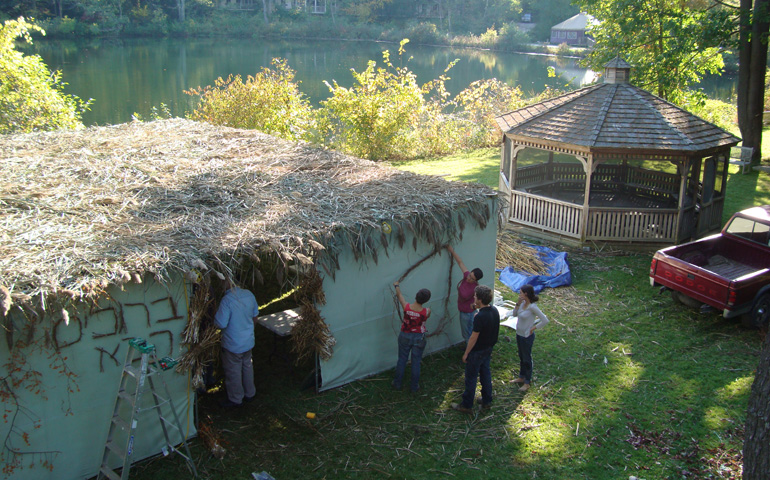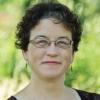
Workers build a sukkah for the Jewish harvest festival Sukkot at Adamah Farm in October 2011. (Fred Bahnson)
Reading the Book of Isaiah on a concrete rooftop in San Cristobál de las Casas, Chiapas, Mexico, God captured Fred Bahnson, inviting him on the path that would lead to a life of farming, he writes in Soil and Sacrament: A Spiritual Memoir of Food and Faith (Simon & Schuster, 2013).
A member of the Christian Peacemakers Team Chiapas in 2001, Bahnson moved on to co-found and serve as director of Anathoth Community Garden, a project of Cedar Grove United Methodist Church in North Carolina. In Soil and Sacrament, he interweaves these experiences with visits to four other “faith-infused gardens”: Mepkin Abbey in South Carolina, where Trappist monks grow mushrooms; The Lord’s Acre, an endeavor with Christian roots near Asheville, N.C.; Tierra Nueva, a Pentecostal ministry in Burlington, Wash., that reaches out to migrant farmworkers, gang members and addicts; and Adamah Farm, a program of the Isabella Freedman Jewish Retreat Center in Falls Village, Conn.
“To grow and share food with others in a garden is to enter a holy country,” writes Bahnson, 40, who now heads the Food, Faith and Religious Leadership Initiative at Wake Forest University School of Divinity in Winston-Salem, N.C. NCR recently spoke with Bahnson about his book and the initiative.
NCR: How did you choose which projects to visit and highlight in your book?
Bahnson: It was a mix of providence and research. Mepkin Abbey, where I visited, I’d already been there twice on retreat. … The monks there grow oyster mushrooms and the Benedictine tradition of which they’re a part is probably the oldest Christian agrarian community in the world. So it made sense to begin with them. …
The Lord’s Acre community -- my wife’s grandfather helped start the original Lord’s Acre in 1930. And her father helped start this recent iteration of the Lord’s Acre, which began in 2009. … So that was another logical step, and it’s near my home up in the mountains of North Carolina.
The Pentecostal farm was really the result of one of the pastors out there who read one of my essays in The Sun magazine. He read what became Chapter 2 in the book, the story of my journey in Chiapas, and wrote me this really nice email. I started learning about Tierra Nueva, and I thought, oh, this is perfect.
Then the Jewish community, I think I learned about just through my connections with the larger food movement.
The communities you visited were in smaller towns or rural areas. Can you talk about how this kind of soil and sacrament spirituality is lived differently or the same in urban areas?
I think it’s only a difference in the matter of scale. The human and spiritual impulse to reconnect with food and reconnect with the land is the same. I think we all have that hunger as people who are created dust from dust, created from soil and inspired with God’s divine breath -- I think we all have that urge to reconnect with the land, and food is one of the easiest ways to do that. In urban areas, there’s a huge interest in community gardens and CSAs [community supported agriculture], partnering with farms outside the city, faith communities starting different food projects. Obviously you can’t grow an acre-size garden in most cities, unless you’re in Detroit. But even a postage-stamp lot, you can grow some herbs and some kale and lettuce, and you still get that benefit of working with the soil, working with plants, reconnecting with creation on even a small scale.
You’ve talked about the concept of regeneration versus sustainability. Can you describe why you prefer the term regeneration?
When I hear the word sustainability, it’s just kind of a blah word. It doesn’t really do much for me. It gives the misperception that if we just replace our current energy use with solar or wind or something, we can keep consuming at the same rate, when all of the signals are indicating that we need to down-power on a massive scale and use a lot less energy.
I’d rather talk about regeneration, especially in terms of the way we grow our food. Regenerative agriculture is agriculture that builds soil rather than depletes soil, or even rather than maintains equilibrium. If you’re practicing regenerative agriculture, you’re actually improving soil in many cases. It takes nature about 500 years to build an inch of topsoil, but in using bio-intensive gardening practices of deep-bed preparation, cover cropping, compost, you can build an inch of soil in about eight years.
That’s a drastic -- I don’t want to say improvement over nature, but regenerative agriculture is a way of becoming a co-creator with God. We’re participating in God’s ongoing work of creation. So we’re not just feeding ourselves, we’re also caring for creation in the process.
An example would be planting pollinator plants in our gardens, where we attract beneficial insects and beneficial birds -- we can create little ecosystems in our gardens that welcome other creatures and that create biodiversity.
Of course, the flip side of that is that we currently have an agriculture that’s heavily focused on mono-crops, that destroys biodiversity, it destroys soil. We’ve lost an estimated third of our topsoil in the past 200 years in America thanks to our industrial farming practices. We’re witnessing huge loss of biodiversity. We have massive dead zones in our oceans, especially in the Gulf of Mexico, as a result of fertilizer runoff. Agriculture as it’s practiced now is really a zero-sum game. It’s incredibly destructive. It’s also bad for our bodies and bad for the people who harvest our food. We have a pretty unjust food system in terms of how farmworkers are paid and how food workers are paid.
So the answer to that whole, big disconnect with industrial eating is to reconnect -- to reconnect with the sources of our food, learn where it’s grown, to participate in some growing of your own food. What I was after in the book was to find those people who are doing that in community. Not just community gardens, but participating in the growing of food with others in a garden in its largest sense. So for the monks, their garden was 3,200 acres. For the Jewish farmers of Adamah, they had a four-acre farm and a picklarium and a goat pasture, so that’s kind of a big garden.
The way that each of the four communities approached growing food was really the mentality of a gardener, and the mentality of the command from Genesis to till and keep the soil -- another translation would be to serve and preserve the fertile soil.
So these four communities that I visited were really doing that. They were modeling a way that we can grow food that feeds our bodies, that feeds the land and that feeds our spirit.
In the book, you quote Tierra Nueva co-founder Bob Ekblad: “The front lines of sustainability should be working with those most wounded by the system.” What are ways that faith communities can put that into action?
The great thing about Tierra Nueva is that they were empowering people to become leaders. They weren’t just giving them handouts of food. They were training them and then lifting them up to positions of leadership.
With the story of Zach Joy that I tell in the book, Zach was a heroin addict and a crystal meth cook. When he became a Christian and started working with Tierra Nueva, he really felt the call to leadership, but he was not able to support himself with a criminal record and a past as an addict. So Bob Ekblad and Chris Hoke, two of the ministers there, had this idea to start a coffee-roasting business that would give Zach a job, really. So Zach is now their chief coffee roaster, and I love that transfer of skills, from crystal meth cook to coffee roaster. He didn’t have to leave his past behind; he just redirected it toward better ends.
Tierra Nueva is a model that other communities can look to in that regard. They see themselves as advocates for people like Zach, empowering them to use the gifts they already have toward good ends.
In terms of food and land, there are just endless opportunities to find the Zachs in our communities and help them find meaningful work growing food. With the inevitable breakdown of our industrial food system, based as it is on cheap oil, we’re going to need a whole lot more people in this country growing food. And growing food is a high and holy calling.
Can you tell me about the work you’re doing with the Food, Faith, and Religious Leadership Initiative?
It started about a year and a half ago. Our mission is to train and equip religious leaders to create more redemptive food systems so that God’s shalom becomes visible for a hungry world. We’re using food as a lens to talk about a number of different related issues: health, energy use, justice, sustainable agriculture. Food is really the meeting point where all those things connect.
We convene leaders and we host workshops and trainings and conferences, retreats. We do a lot of work with continuing education -- for example, Nov. 7 we’re doing a conference on food, faith and justice. We’ve partnered with a number of African-American churches in Winston-Salem, looking at how churches and faith communities there can use their land, their resources, their volunteer base to improve food access in urban areas. That’s an interfaith conference. We’re partnering with a Jewish temple as well; we have a local imam who’s going to speak. I’m really excited about that one.
I also teach a four-day workshop called “Field, Table, Communion.” … We bring in a biblical scholar, a wild forager, a permaculture expert, and I do some classes on gardening and theology. It’s a big mishmash of theology and regenerative agriculture, permaculture and talking about the Lord’s Supper.
Is the initiative’s work locally focused?
Yes. We have two geographic focal areas: Winston-Salem-Piedmont area of North Carolina, and then Asheville in western North Carolina.
Basically, one part of the initiative is the continuing ed; the other part is that we’re training current divinity students in all of these issues. We have a food and faith certificate that they can get as part of their [Master of Divinity]. We bring in visiting speakers. We have different classes offered on issues related to food and faith. One of our faculty, Derek Hicks, teaches a class on African-American food ways.
We’re convening a lot of conversations around food and faith. … It feels like, for me personally, the continuation of a trajectory that I’ve been on that began 12 years ago in Chiapas and I’m still on the journey now. In terms of being part of this larger conversation around the country, we’re the only divinity school that I know of that has an initiative like this. It feels like we’re at the edge of a really important conversation.
[Teresa Malcolm is NCR special sections editor and copy editor. Her email address is tmalcolm@ncronline.org.]

